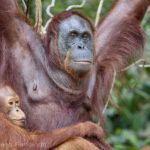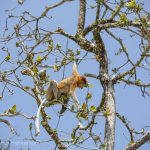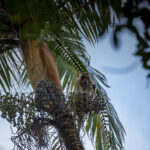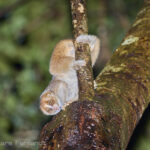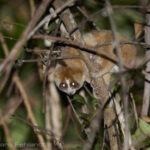Red leaf monkey, Presbytis rubicunda (S. Müller, 1838) of Danum Vallay/Sabah and Central Sarawak – Borneo
Presbytis rubicunda is an Old World colobine endemic to Borneo and the adjacent Karimata Island where it inhabits evergreen lowland dipterocarp forest as well as peat and other swamp forests and spends most of its time in the canopy. Its diet is dominated by young leaves but includes fruits, seeds and flowers, with pronounced seasonal seed predation during periods of high fruiting documented in northern Borneo. Individuals also practice geophagy by consuming soil from termite mounds which is thought to supply minerals and adsorb plant secondary compounds. Like other colobines the species has a sacculated foregut that supports microbial fermentation of fibrous plant matter and enables efficient leaf digestion. Social organization is typically a single male multi female group with additional males occurring alone or in all male bands. The species is currently assessed as Vulnerable on the IUCN Red List with an overall decreasing trend and its distribution encompasses Indonesian Kalimantan and the Malaysian states of Sabah and Sarawak including the small offshore Karimata Island. The name reflects both taxonomy and coloration. The genus name Presbytis derives from Greek and literally means old woman the feminine of presbytes old man while the specific epithet rubicunda comes from the Latin rubicundus meaning ruddy or reddish and refers to the characteristic maroon to rufous pelage. The taxon was first described by Salomon Müller in 1838 under the name Semnopithecus rubicundus and later placed in Presbytis.

